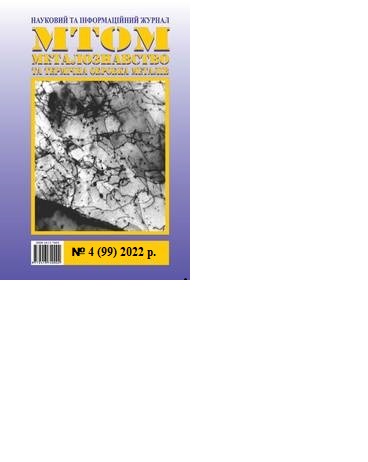DEVELOPMENT AND RESEARCH OF NEW NANOMATERIALS FOR ELECTRONICS OF THE ZnSXSe1-X TYPE OBTAINED BY THE COMBUSTION SYNTHESIS METHOD
DOI:
https://doi.org/10.30838/J.PMHTM.2413.271222.47.910Keywords:
ZnSxSe1-x nanocrystals, combustion synthesis method, X-ray diffraction analysis, crystal structure, EPR spectraAbstract
Introduction. Nanocrystals of ZnSxSe1-x solid solutions were synthesized by the combustion synthesis method with a parameter step of x = 0.2, with reproducible and controlled properties and low cost. Results. The composition of the charge placed before synthesis and the powder obtained after synthesis is different. The sizes of ZnSxSe1-x nanocrystals calculated by the Debye-Scherrer method ranged from 60±5 nm to 80±5 nm. The obtained degrees of microstress and dislocation density are characteristic of homogeneous compositions with high perfection of the crystal structure. NCs are characterized by the presence of hexagonal and cubic phases for all parameters of x composition. When the parameter x decreases in nanocrystals of ZnSxSe1-x solid solutions, the proportion of the cubic phase increases. A hyperfine structure characteristic of paramagnetic Mn2+ centers is observed in the EPR spectra of all compositions. In compositions with 0.4 ≤ x ≤ 1, there is a duality of the EPR caused by a different local environment of Mn2+ ions. According to the change in the EPR hyperfine structure due to constants from A = 6.88÷6.91 mT to A = 6.55 mT, it can be concluded that Mn2+ ions are surrounded by sulfur ions in compositions with 0.4 ≤ x ≤ 1, and Mn2+ ions are surrounded by selenium ions in compositions with x ≤ 0.2. Unexposed ZnSxSe1-x nanocrystals in compositions with 0.8 ≤ x ≤ 1 have a single EPR line of Cr+ ions. Conclusions. The obtained nanocrystals are recommended for use in the following areas of industry: materials for nanoelectronics, domes of missiles for the military sphere, or durable protective coatings.

Downloads
Published
Issue
Section
License
Authors that are published in this journal agree to follow the conditions:
Authors reserve the right to the authorship of his work and cede the right to the journal of first publication of this work on conditions of the license under the Creative Commons Attribution License, which allows others to distribute it freely with the obligatory reference to the author of the original work and the first publication of the work in this journal.
